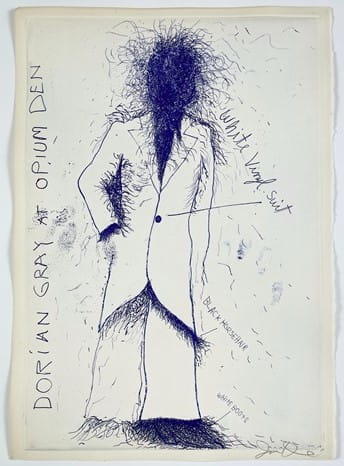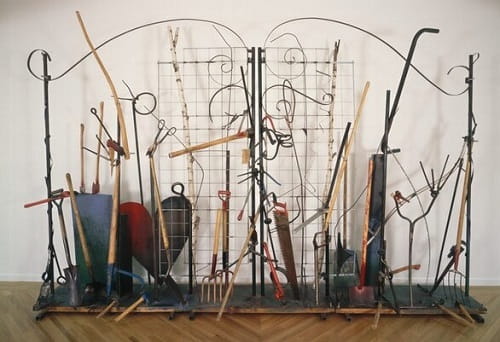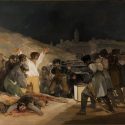Jim Dine ‘s Life and Art
Jim Dine, the renowned American artist, has left an indelible mark on the world of contemporary art. His unique blend of Pop Art and Abstract Expressionism has captivated art enthusiasts and collectors alike.
In this blog post, we will take you on a journey through the life and art of Jim Dine, uncovering the key moments of his career and the profound impact of his work on the art world.
Jim Dine: The Artistic Odyssey of an American Icon
Early Life and Influences
Jim Dine’s artistic journey was shaped by his upbringing, personal experiences, and a wide range of influences.

Jim Dine (June 16, 1935 – )
1- Family Background
Jim Dine was born on June 16, 1935, in Cincinnati, Ohio.
Dine grew up in a family of craftsmen, which included his grandfather, who was a cabinetmaker, and his father, who owned a hardware store. This exposure to tools, materials, and the world of craftsmanship would have a profound impact on Dine’s later artistic endeavors.

Pinocchio, 2008 by Jim Dine.
2- Literary Influences
In addition to his family background, Dine was heavily influenced by literature and poetry. He developed a deep appreciation for the classics and poetry during his formative years. This literary influence would find its way into his art, as he often incorporated text and poetic elements into his works.

White Vinyl Suit from ‘The Picture of Dorian, 1968.
3- Early Education
Dine attended Walnut Hills High School in Cincinnati, where he began to explore his artistic talents. His high school art teacher recognized his potential and encouraged him to pursue his passion for art.
4- Move to New York City
In 1958, at the age of 23, Dine made a pivotal decision to move to New York City, a hub for artistic innovation and the epicenter of the emerging Pop Art movement.
This move marked the beginning of his professional artistic career.

Tool Box IX (Shiny Acetate), 1966.
Artistic Evolution
Jim Dine’s early artistic journey was characterized by experimentation and a departure from traditional artistic norms.
1- Early Works
Dine’s early works were marked by a fascination with everyday objects, such as tools, bathrobes, and hearts. These objects were not merely subjects of his art; they were symbols laden with personal and emotional significance.

The Woodcut Bathrobe, 1975 – MoMA.
2- Mixed Media and Techniques
Dine was known for his innovative use of mixed media, including painting, drawing, collage, and assemblage. He often incorporated found objects into his art, blurring the lines between sculpture and painting.

The Gate, Goodbye Vermont, 1985 by Jim Dine.
3- Iconic Motifs
Two of Dine’s iconic motifs, hearts and tools, became recurring themes in his art.
The heart symbolized love, but it also represented his introspective and emotional journey.
Dine use of tools was a nod to his family’s background and a tribute to craftsmanship.

The Forest Up North, 1993.
4- Pop Art Influence
While Dine’s work had elements of abstraction and expressionism, it was also influenced by the Pop Art movement. Like other Pop artists, he drew inspiration from consumer culture and popular imagery but infused it with a deeply personal and emotional dimension.
Jim Dine’s early life and artistic journey laid the foundation for a career that would challenge artistic conventions and leave an indelible mark on the art world. His unique blend of personal symbolism, innovative techniques, and literary influences set him apart as a distinctive and influential artist.
As he continued to evolve as an artist, his work would become increasingly celebrated, making him a significant figure in contemporary art.
Jim Dine’s Iconic Works
1- Heart Series
Perhaps one of Jim Dine’s most recognizable and enduring motifs is the heart. His fascination with this universal symbol of love and emotion led to a series of artworks featuring heart shapes in various forms.

Two Hearts at Sunset, 2005.
These hearts were not merely representations of love; they served as windows into Dine’s introspective and emotional world.
Jim Dine’s hearts were often rendered in bold, vibrant colors, exuding a sense of passion and intensity. He used a variety of mediums, including painting, drawing, and printmaking, to explore this motif.

The Heart on the Rock, 1983.
The heart series embodies the duality of love – its warmth and tenderness, as well as its capacity for pain and vulnerability.
Dine’s Hearts invites viewers to contemplate the complexities of human emotions.
2- Tool Series
Jim Dine‘s deep-rooted connection to craftsmanship and his family’s background in hardware stores inspired another iconic series – the tool series. This body of work celebrated the tools of the trade, including hammers, saws, and wrenches.

Twelve Colorful Tools (For Gene Summers), 2017.
Dine’s tools were often depicted with a sense of reverence and nostalgia. They were not mere objects; they symbolized the artist’s intimate relationship with his craft and the act of creation.

Bolt Cutters (first state), 1972 by Jim Dine.
Through the tool series, Dine explored the idea that artists, like craftsmen, rely on their tools to shape and mold their vision. The series is a tribute to the process of art-making and the tangible connection between an artist and their materials.
3- Self-Portrait Series
Dine’s self-portraits offer a unique and intimate perspective into the artist’s psyche. These works are characterized by a raw vulnerability and introspection rarely seen in self-portraiture.

Jim Dine Self-Portrait, 2019.
In his self-portraits, Dine often depicted himself in a variety of emotional states – sometimes joyful and playful, at other times contemplative or even melancholic. These self-reflections allowed viewers to connect with the artist on a deeply personal level.

Jim Dine Self-Portrait, 1959.
The self-portrait series is a testament to Dine’s willingness to expose his own humanity, showcasing the artist as both subject and observer, exploring the multifaceted nature of identity and self-expression.
4- Pop Art Collaborations
While Jim Dine is often associated with the Pop Art movement, his approach was distinctive. He collaborated with other Pop artists, including Andy Warhol and Roy Lichtenstein, during the 1960s.
Dine’s collaborations resulted in artworks that blended his personal, emotionally charged style with the aesthetic of Pop Art. For instance, his collaboration with Warhol produced a series of prints that featured both artists’ signatures and playful experimentation with image repetition.
These collaborations provided a fascinating intersection of artistic styles and ideologies, highlighting Dine’s ability to infuse Pop Art with a deeply personal touch.
5- Monumental Sculptures
In addition to his two-dimensional works, Jim Dine ventured into the realm of sculpture, creating monumental pieces that left a lasting impression. Notable among these is his “The Crommelynck Gate” sculpture, a massive bronze work featuring tools and other objects.

The Crommelynck Gate with Tools, 1983.
Dine’s sculptures, much like his paintings, emphasize the physicality of art-making and the tactile relationship between artist and material. They invite viewers to engage with art on a grand scale, blurring the boundaries between art and the surrounding environment.
Jim Dine’s iconic works span a wide range of mediums and themes, each bearing his distinctive emotional and artistic imprint. These artworks have not only contributed to the evolution of contemporary art but also continue to resonate with audiences, inviting them to explore the depths of human emotion and the creative process.
References:
- https://en.wikipedia.org/wiki/Jim_Dine
- https://www.artnet.com/artists/jim-dine/
- https://www.artsy.net/artwork/jim-dine-tool-box-ix-shiny-acetate
- https://www.moma.org/collection/works/65130
- https://www.nga.gov/collection/art-object-page.72320.html
- https://novakart.com/artists/jim-dine/jim-dine-hearts/
- https://www.artsy.net/artist-series/jim-dine-hearts
- https://www.artsy.net/artwork/jim-dine-two-hearts-at-sunset-53
- https://www.artsy.net/artwork/jim-dine-the-heart-on-the-rock
- https://novakart.com/artists/jim-dine/jim-dine-tools/
- https://www.artnet.com/artists/jim-dine/bolt-cutters-first-state-a-n6xEoUEq5J6qdj00DwbjuA2
- https://www.artsy.net/artwork/jim-dine-jim-dine-self-portrait
- https://www.metmuseum.org/art/collection/search/485927
- https://www.metmuseum.org/art/collection/search/484953









Your article was a great read! You have a way of making topics resonate with a wide audience.
Thank you Sztuki.